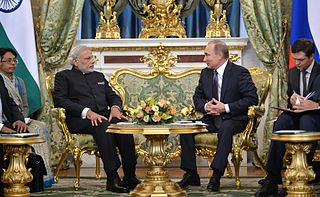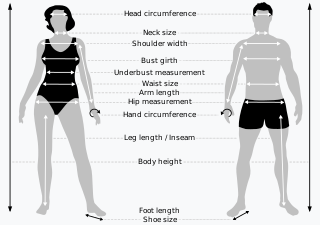
Knitting is a method by which yarn is manipulated to create a textile or fabric; it is used in many types of garments. Knitting may be done by hand or by machine.

The kimono (きもの/着物) is a traditional Japanese garment and the national dress of Japan. The kimono is a T-shaped, wrapped-front garment with square sleeves and a rectangular body, and is worn with the left side wrapped over the right side, unless the wearer is deceased. The kimono is traditionally worn with an obi, and is commonly worn with accessories such as zōri sandals and tabi socks.

A suit is a set of men's or women's clothes comprising a suit jacket, or coat, and trousers. When of identical textile, and worn with a collared dress shirt, necktie, and dress shoes, it is traditionally considered informal wear in Western dress codes. The lounge suit originated in 19th-century Britain as more casual wear alternative for sportswear and British country clothing. After replacing the black frock coat in the early 20th century as regular daywear, a sober one-coloured suit became known as a lounge suit. A darker, understated lounge suit for professional occasions became known as a business suit.

A tailor is a person who makes, repairs, or alters clothing professionally, especially suits and men's clothing.

A frock coat is a formal man's coat characterised by a knee-length skirt cut all around the base just above the knee, popular during the Victorian and Edwardian periods (1820s–1920s). It is a fitted, long-sleeved coat with a centre vent at the back and some features unusual in post-Victorian dress. These include the reverse collar and lapels, where the outer edge of the lapel is often cut from a separate piece of cloth from the main body and also a high degree of waist suppression around the waistcoat, where the coat's diameter round the waist is less than round the chest. This is achieved by a high horizontal waist seam with side bodies, which are extra panels of fabric above the waist used to pull in the naturally cylindrical drape. As was usual with all coats in the 19th century, shoulder padding was rare or minimal.

A bathrobe, also known as a housecoat, is a robe, a loose-fitting outer garment, worn by people. Bathrobes may sometimes be worn after a body wash or around a pool.

A camisole is a sleeveless undergarment / innerwear typically worn by women, normally extending to the waist. The camisole is usually made of satin, nylon, silk, or cotton.

The joint European standard for size labelling of clothes, formally known as EN 13402 Size designation of clothes, is a European standard for labelling clothes sizes which has been partially adopted, and aims to make it easier to find and select fitting clothes. The standard is based on body dimensions measured in centimetres, and as such aims to allow for finding fitting clothing sizes by measuring the body with a tape measure or by comparing to already fitting clothing which conforms to the EN 13402 standard. The standard can therefore contribute to more environmentally friendly trade as it can lead to less return of clothes bought on the internet.

In sewing and fashion design, a pattern is the template from which the parts of a garment are traced onto fabric before being cut out and assembled. Patterns are usually made of paper, and are sometimes made of sturdier materials like paperboard or cardboard if they need to be more robust to withstand repeated use. The process of making or cutting patterns is sometimes condensed to the one-word Patternmaking, but it can also be written pattern(-)making or pattern cutting.
For woven textiles, grain refers to the orientation of the weft and warp threads. The three named grains are straight grain, cross grain, and the bias grain. In sewing, a pattern piece can be cut from fabric in any orientation, and the chosen grain or orientation will affect the way the fabric hangs and stretches and thus the fit of a garment. Generally speaking a piece is said to be cut on a particular grain when the longest part of the pattern or the main seams of the finished piece are aligned with that grain. Non-woven materials such as felt, interfacing or leather do not have a grain.

Latex rubber is used in many types of clothing. Rubber has traditionally been used in protective clothing, including gas masks and Wellington boots. Rubber is now generally being replaced in these application by plastics. Mackintoshes have traditionally been made from rubberized cloth.

In sewing, a gusset is a triangular or rhomboidal piece of fabric inserted into a seam to add breadth or reduce stress from tight-fitting clothing. Gussets were used at the shoulders, underarms, and hems of traditional shirts and chemises made of rectangular lengths of linen to shape the garments to the body.
Sweater design is a specialization of fashion design in which knitted sweaters are designed to fulfill certain aesthetic, functional and commercial criteria. The designer typically considers factors such as the insulating power of the sweater ; the fashion of its colors, patterns, silhouette and style lines, particularly the neckline and waistline; the convenience and practicality of its cut; and in commercial design, the cost of its production and the profitability of its price point. Sweater designs are often published in books and knitting magazines. Sweater design is an old art, but continues to attract new designers such as Nicky Epstein and Meg Swansen.

Knitted fabric is a textile that results from knitting, the process of inter-looping of yarns or inter-meshing of loops. Its properties are distinct from woven fabric in that it is more flexible and can be more readily constructed into smaller pieces, making it ideal for socks and hats.

Clothing size refers to the label sizes used for garments sold off-the-shelf. There are a large number of standard sizing systems around the world for various garments, such as dresses, tops, skirts, and trousers. Made-to-order garments require measurements to be taken, but these do not need to be converted into national standard form.

Bra size indicates the size characteristics of a bra. While there are a number of bra sizing systems in use around the world, the bra sizes usually consist of a number, indicating the size of the band around the woman's torso, and one or more letters that indicate the breast cup size. Bra cup sizes were first invented in 1932 while band sizes became popular in the 1940s. For convenience, because of the impracticality of determining the size dimensions of each breast, the volume of the bra cup, or cup size, is based on the difference between band length and over-the-bust measurement.
Made-to-measure (MTM) typically refers to custom clothing that is cut and sewn using a standard-sized base pattern. Suits and sport coats are the most common garments made-to-measure. The fit of a made-to-measure garment is expected to be superior to that of a ready-to-wear garment because made-to-measure garments are constructed to fit each customer individually based on a few body measurements to customize the pre-existing pattern. Made-to-measure garments always involve some form of standardization in the pattern and manufacturing, whereas bespoke tailoring is entirely made from scratch based on a customer's specifications with far more attention to minute fit details and using multiple fittings during the construction process. All else being equal, a made-to-measure garment will be more expensive than a ready-to-wear garment but cheaper than a bespoke one. "Custom made" most often refers to MTM. Country of origin makes a difference in pricing, with made in China MTM garments typically priced below made in Italy ready-to-wear.

Darts are folds and sewn into fabric to take in ease and provide shape to a garment, especially for a woman's bust. They are used frequently in all sorts of clothing to tailor the garment to the wearer's shape, or to make an innovative shape in the garment. Fabric may be thought of as flat, and a dart has the effect of removing a wedge shaped piece and pulling the edges of that wedge together to create a shallow cone. This effect can be seen quite easily with a paper pattern by pulling together the edges of a dart intake as it would be sewn. Since fabric is generally more flexible than paper the fabric will shift around the apex of the cone and form a softer, but still curved, shape. In a garment a dart ends in a point at a full area of the body.
Sewing is the craft of fastening or attaching objects using stitches made with needle and thread. Sewing is one of the oldest of the textile arts, arising in the Paleolithic Era. Although usually associated with clothing and household linens, sewing is used in a variety of crafts and industries, including shoemaking, upholstery, sailmaking, bookbinding and the manufacturing of some kinds of sporting goods. Sewing is the fundamental process underlying a variety of textile arts and crafts, including embroidery, tapestry, quilting, appliqué and patchwork.














